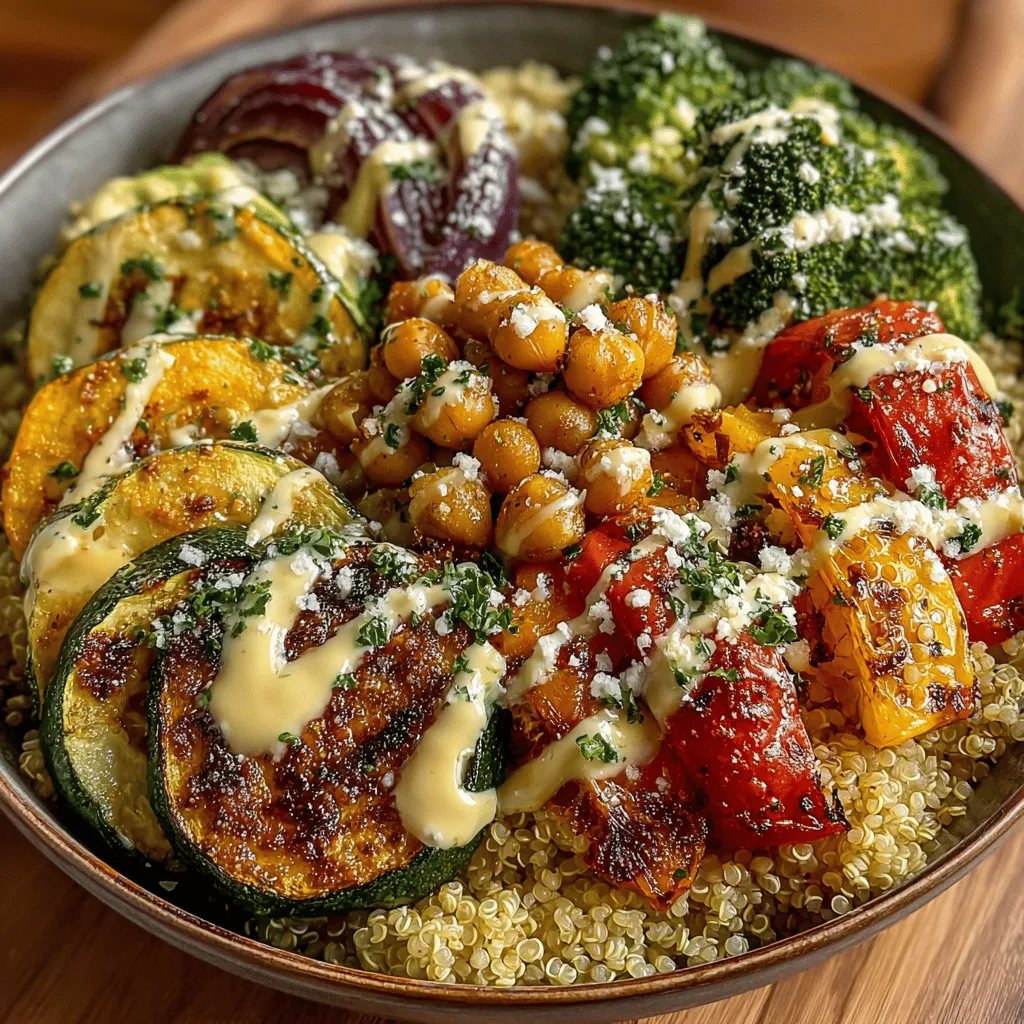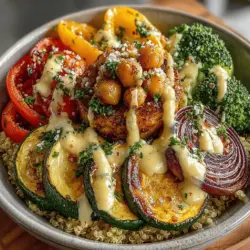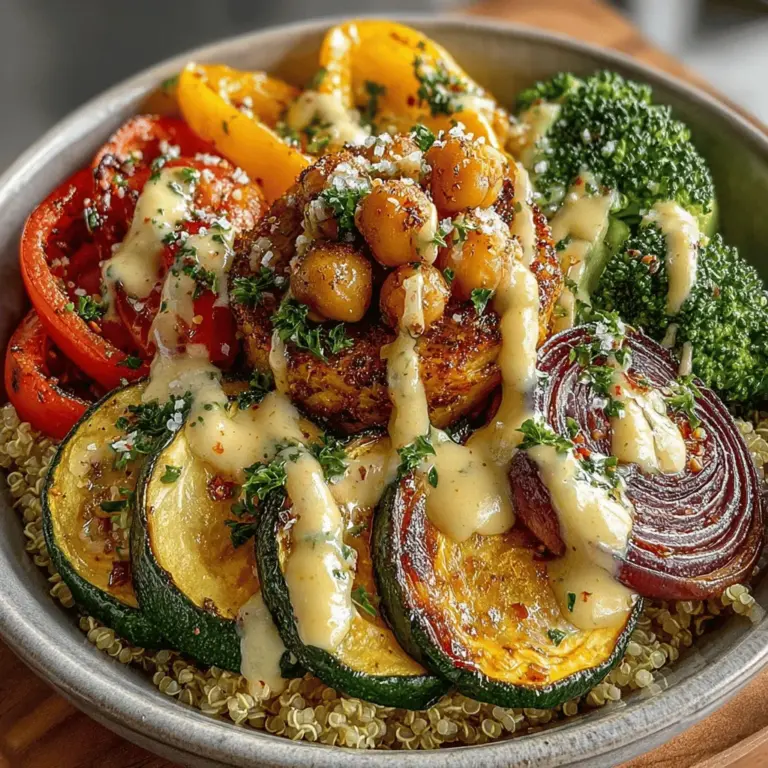Colorful Quinoa and Roasted Veggie Power Bowls: A Nutritious Delight
In the quest for healthy and satisfying meals, Colorful Quinoa and Roasted Veggie Power Bowls stand out as a vibrant and nutritious option. Perfect for both lunch and dinner, these power bowls combine protein-rich quinoa with an array of roasted vegetables and a creamy tahini dressing. This dish is not only a feast for the eyes but also packed with essential nutrients, making it an ideal choice for those looking to enhance their well-being without sacrificing flavor.
As we navigate through the complexities of modern diets, it’s crucial to find meals that are both nourishing and enjoyable. Colorful Quinoa and Roasted Veggie Power Bowls fit the bill perfectly, providing a harmonious balance of carbohydrates, proteins, and healthy fats. In this article, we will delve into the recipe, explore its health benefits, and provide a comprehensive guide to creating your own delicious power bowls.
Understanding the Ingredients
The Foundation: Quinoa
Quinoa, often hailed as a superfood, serves as the perfect base for our power bowls. Unlike many grains, quinoa is a complete protein, meaning it contains all nine essential amino acids that our bodies cannot produce on their own. This unique characteristic makes it an excellent choice for vegetarians and vegans seeking to fulfill their protein needs.
Additionally, quinoa is rich in fiber, which aids in digestion and helps keep you feeling full longer. It is packed with important vitamins and minerals, including magnesium, iron, and B-vitamins, contributing to overall health. The nutty flavor and slightly chewy texture of quinoa make it not only nutritious but also a delicious addition to any meal.
The Veggie Variety
A colorful array of vegetables makes these power bowls visually appealing and nutritionally comprehensive. For this recipe, we will be using zucchini, red bell pepper, cherry tomatoes, red onion, and broccoli. Each of these vegetables brings its own unique set of health benefits to the dish:
– Zucchini: Low in calories but high in vitamins C and A, zucchini adds moisture and a subtle sweetness to the power bowl.
– Red Bell Pepper: Packed with antioxidants, red bell peppers are known for their high vitamin C content, which supports immune health and skin vitality.
– Cherry Tomatoes: These bite-sized gems are rich in lycopene, an antioxidant linked to numerous health benefits, including heart health.
– Red Onion: With its powerful anti-inflammatory and antioxidant properties, red onion adds a sharp flavor that complements the sweetness of the other vegetables.
– Broccoli: This cruciferous vegetable is a nutritional powerhouse, known for its cancer-fighting properties and high levels of vitamins K and C.
The importance of colorful vegetables in a balanced diet cannot be overstated. Each color represents different phytonutrients that contribute to health in various ways. By incorporating a rainbow of vegetables into your meals, you ensure that you receive a broad spectrum of nutrients.
The Chickpeas: A Protein Powerhouse
Chickpeas, or garbanzo beans, are another essential ingredient in our Colorful Quinoa and Roasted Veggie Power Bowls. They are a fantastic source of plant-based protein, making them an ideal addition for those following vegetarian or vegan diets.
Nutritionally, chickpeas are rich in fiber and several key vitamins and minerals, including folate, manganese, and iron. Their high fiber content aids in digestion and helps regulate blood sugar levels, making them a smart choice for maintaining energy throughout the day. Chickpeas not only enhance the protein content of the dish but also add a creamy texture that complements the other ingredients.
Creating Flavor with Spices and Oils
To elevate the flavor profile of our power bowls, we will use a combination of olive oil, garlic powder, and smoked paprika. Olive oil, particularly extra virgin, is renowned for its heart-healthy monounsaturated fats and anti-inflammatory properties. It serves as an excellent base for roasting our vegetables, allowing them to caramelize beautifully while enhancing their natural flavors.
Garlic powder adds a savory depth that pairs well with the sweetness of the roasted veggies. Smoked paprika lends a subtle smokiness that transforms the dish into a comforting meal. These spices not only enhance the taste but also contribute additional health benefits, making the dish even more appealing.
Crafting the Tahini Dressing
No power bowl is complete without a delicious dressing to tie all the flavors together. In this recipe, we will create a creamy tahini dressing that is both nutritious and flavorful. Tahini, made from ground sesame seeds, is rich in healthy fats, protein, and several vitamins and minerals, including calcium and magnesium.
The dressing will be enhanced with fresh lemon juice, which adds brightness and acidity, balancing the richness of the tahini. A splash of water will help achieve the desired consistency, making it easy to drizzle over the power bowls. This tahini dressing not only complements the flavors of the quinoa and vegetables but also contributes essential nutrients that support overall health.
Step-by-Step Preparation
Preparing the Quinoa: A Simple Guide
Now that we’ve explored the ingredients, let’s dive into the preparation of our Colorful Quinoa and Roasted Veggie Power Bowls. The first step is to prepare the quinoa, which is relatively straightforward but requires some attention to detail to achieve that fluffy texture we all love.
1. Rinse the Quinoa: Start by placing the quinoa in a fine-mesh strainer and rinsing it under cold water for about 2 minutes. This step is crucial as it removes the natural coating called saponin, which can impart a bitter taste.
2. Cook the Quinoa: In a medium saucepan, combine 1 cup of rinsed quinoa with 2 cups of water. Bring the mixture to a boil over medium-high heat. Once boiling, reduce the heat to low, cover the saucepan, and let it simmer for about 15 minutes or until the quinoa has absorbed all the water.
3. Fluff the Quinoa: After the cooking time is complete, remove the saucepan from heat, and let it sit covered for an additional 5 minutes. This resting period allows the quinoa to steam and become even fluffier. Finally, use a fork to fluff the quinoa before serving.
4. Season: For added flavor, consider seasoning the quinoa with a pinch of salt or a drizzle of olive oil once it’s fluffed.
Roasting the Vegetables: Techniques for Perfection
With the quinoa prepared, it’s time to roast our colorful vegetables to bring out their natural sweetness and enhance their flavors.
1. Preheat the Oven: Preheat your oven to 425°F (220°C). A high temperature is key to achieving that perfect caramelization on the vegetables.
2. Prepare the Vegetables: While the quinoa is cooking, wash and chop your vegetables into uniform pieces to ensure even roasting. For this recipe, cut the zucchini into half-moons, slice the red bell pepper into strips, halve the cherry tomatoes, chop the red onion, and cut the broccoli into florets.
3. Season and Toss: Place the chopped vegetables in a large mixing bowl. Drizzle with olive oil, then sprinkle with garlic powder, smoked paprika, and salt. Toss everything together until the vegetables are evenly coated with the oil and seasonings.
4. Roast: Spread the seasoned vegetables in a single layer on a baking sheet lined with parchment paper. This prevents sticking and makes for easy cleanup. Roast in the preheated oven for about 20-25 minutes, stirring halfway through, until the vegetables are tender and slightly caramelized.
In the upcoming sections of this article, we will continue to explore how to assemble these vibrant power bowls, as well as share tips for customizing the recipe to suit your personal preferences. By the end, you will be equipped with all the knowledge needed to create your own Colorful Quinoa and Roasted Veggie Power Bowls that are not only nutritious but also bursting with flavor.

Preheating the Oven and Preparing the Baking Sheet
Before diving into the heart of this recipe, it’s essential to prepare your kitchen for the deliciousness that is about to unfold. Preheat your oven to 425°F (220°C). This high temperature will help to caramelize the vegetables, resulting in a rich, sweet flavor that complements the nuttiness of the quinoa.
While the oven heats, line a baking sheet with parchment paper or a silicone baking mat. This step not only makes for easy cleanup but also prevents the vegetables from sticking to the sheet, allowing them to roast evenly and develop a beautiful golden-brown exterior. Ensure you have enough space on the sheet for the vegetables to spread out without overcrowding, which is key to achieving that perfect roast.
Step-by-Step Instructions for Seasoning and Roasting Vegetables
1. Prepare the Vegetables: Start by washing and slicing your choice of vegetables. Popular options include bell peppers, zucchini, sweet potatoes, and red onions. Aim for uniform sizes to ensure even cooking.
2. Season the Vegetables: Place the chopped vegetables in a large mixing bowl. Drizzle with olive oil (about 2-3 tablespoons) and sprinkle with salt, pepper, and any other seasonings you prefer, such as paprika, garlic powder, or dried herbs like thyme or rosemary. Toss everything together until the vegetables are well-coated in the oil and seasonings.
3. Spread on the Baking Sheet: Transfer the seasoned vegetables to the prepared baking sheet, spreading them out in a single layer. This is crucial for roasting as it allows the hot air to circulate around each piece, enhancing caramelization.
4. Roast: Place the baking sheet in the preheated oven and roast the vegetables for about 25-30 minutes, tossing them halfway through to ensure even cooking. Keep an eye on them during the last few minutes to avoid burning; the vegetables should be tender and slightly charred when done.
Importance of Cooking Time and Temperature for Flavor Development
Roasting at 425°F allows the vegetables to cook quickly while caramelizing their natural sugars, enhancing their flavor profile. This method not only brings out the sweetness in root vegetables but also intensifies the savory notes in others. Timing is key; undercooked vegetables may taste bland while overcooked ones can become mushy. Aim for a perfect balance to achieve that satisfying texture while maximizing flavor.
Making the Chickpea Dressing: Whisking It Together
While the vegetables are roasting, it’s time to prepare a creamy tahini dressing that will elevate your power bowl to the next level.
1. Gather Your Ingredients: For this dressing, you’ll need:
– 1/4 cup tahini
– 2 tablespoons lemon juice (freshly squeezed for best results)
– 1 tablespoon maple syrup or honey (optional for sweetness)
– 2-4 tablespoons water (to achieve your desired consistency)
– Salt and pepper to taste
2. Whisk Together: In a medium mixing bowl, combine the tahini, lemon juice, and maple syrup (if using). Whisk until the mixture is smooth. As tahini can be thick, slowly add water, one tablespoon at a time, until the dressing reaches a pourable consistency.
3. Season and Adjust: Taste the dressing and adjust the seasoning with salt and pepper, or more lemon juice if you prefer a tangier flavor. The dressing should be creamy yet fluid enough to drizzle over your power bowls.
Tips for Achieving the Perfect Consistency
The key to a great tahini dressing lies in the balance of ingredients. If your dressing is too thick, whisk in more water gradually until you reach your desired consistency. Conversely, if it’s too thin, add a bit more tahini or a dash of Greek yogurt for creaminess. The flavor should be a balance of nutty, tangy, and slightly sweet, providing a perfect counterpart to the roasted vegetables.
Assembling the Power Bowls: A Layered Approach
Now comes the fun part — assembling your colorful power bowls! This step allows you to showcase the vibrant ingredients and create a visually appealing dish that is as delightful to look at as it is to eat.
1. Start with Quinoa: Begin by adding a generous scoop of cooked quinoa to the bottom of each bowl. This grain forms the base of your power bowl, providing a hearty texture and a source of protein.
2. Layer the Roasted Vegetables: Next, artfully arrange your roasted vegetables on top of the quinoa. Aim for a variety of colors and shapes to make the bowl visually appealing. Feel free to mix and match depending on the vegetables you roasted.
3. Add Protein: If desired, top your bowl with a scoop of chickpeas or your choice of protein, such as grilled chicken or tofu.
4. Drizzle with Dressing: Finally, drizzle the tahini dressing over the top, allowing it to cascade down the sides. You can also serve the dressing on the side for those who prefer to control how much they add.
Suggestions for Portion Sizes of Each Component
A well-balanced power bowl typically includes:
– Quinoa: About 1/2 cup cooked per bowl.
– Roasted Vegetables: Approximately 1 cup total, divided among your choices.
– Protein: 1/2 cup chickpeas or equivalent protein source.
– Dressing: 2 tablespoons to taste.
Adjust these portions based on individual dietary needs and preferences!
Nutritional Benefits of the Power Bowl
A Balanced Meal in One Bowl
These Colorful Quinoa and Roasted Veggie Power Bowls are a perfect representation of a balanced meal. Each bowl provides a harmonious blend of macronutrients:
– Proteins: Quinoa and chickpeas are both excellent plant-based protein sources, essential for muscle repair and growth.
– Carbohydrates: The quinoa and roasted vegetables provide complex carbohydrates that supply sustained energy.
– Fats: The tahini dressing adds healthy fats crucial for nutrient absorption and overall health.
Importance of Fiber and Its Health Benefits
One of the standout features of this power bowl is its high fiber content, which comes from the quinoa, chickpeas, and a variety of vegetables. Fiber is vital for digestive health, helps maintain steady blood sugar levels, and can aid in weight management by promoting a feeling of fullness.
Vitamins and Minerals Galore
The ingredients in this recipe are packed with essential vitamins and minerals. For example:
– Quinoa: Rich in magnesium, iron, and B vitamins.
– Chickpeas: A great source of folate, manganese, and protein.
– Vegetables: Provide a spectrum of nutrients, including vitamin C (from bell peppers), potassium (from sweet potatoes), and antioxidants (from a variety of colorful vegetables).
These nutrients are essential for maintaining energy levels, supporting immune function, and promoting overall health.
The Role of Plant-Based Meals
Incorporating plant-based meals like this power bowl into your diet has numerous health benefits. Research shows that plant-based diets can lower the risk of chronic diseases such as heart disease, diabetes, and certain cancers. They also promote a healthier weight and improve gut health due to their high fiber content.
This recipe aligns perfectly with healthy eating guidelines by emphasizing whole foods, nutrient density, and variety — all essential components of a well-rounded diet.
Serving Suggestions and Variations
Customizing Your Power Bowl
One of the best aspects of power bowls is their versatility. Here are a few suggestions for optional toppings to personalize your dish:
– Avocado: Add sliced or diced avocado for creaminess and healthy fats.
– Feta Cheese: Crumbled feta introduces a salty flavor that contrasts beautifully with the sweetness of the roasted vegetables.
– Hummus: A dollop of hummus can provide additional creaminess and flavor, while also boosting protein content.
Exploring Seasonal Variations
Take advantage of seasonal vegetables to keep the recipe fresh and exciting throughout the year. For example:
– Spring: Incorporate asparagus and peas for a light, fresh flavor.
– Summer: Use zucchini, corn, and cherry tomatoes for a vibrant and colorful bowl.
– Fall: Roasted Brussels sprouts and squash add a warm, hearty touch.
– Winter: Sweet potatoes and root vegetables provide comforting flavors during the colder months.
Additionally, don’t shy away from enhancing flavors with fresh herbs like cilantro, parsley, or basil, or spices like cumin, coriander, or chili powder to give your bowls a unique twist.
Conclusion
Colorful Quinoa and Roasted Veggie Power Bowls are not only a feast for the eyes but also a nourishing, wholesome meal option for anyone looking to eat healthier. With their vibrant colors, rich flavors, and diverse textures, these power bowls offer a satisfying dining experience that can easily be tailored to personal preferences. Whether you enjoy them as a quick lunch or a hearty dinner, this recipe serves as a reminder that nutritious food can also be delicious and enjoyable. Embrace the power of plants and savor the goodness in every bite.


